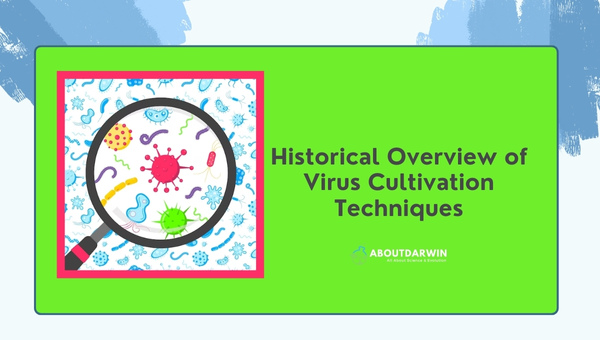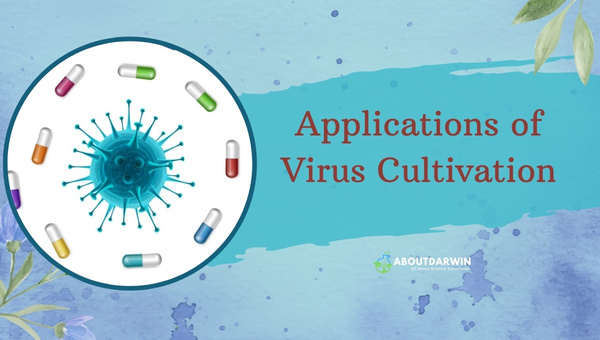Physical Address
304 North Cardinal St.
Dorchester Center, MA 02124
Virus Cultivation: a fascinating, intricate scientific practice that has evolved tremendously over the years. As a method for growing and propagating viruses in controlled conditions, virus cultivation is as intriguing as it is vital, playing a significant role in everything from vaccine development to disease diagnosis.
In this blog post, we’ll journey together through the technical world of virus cultivation. From its humble beginnings to its current state-of-the-art techniques, there’s an abundance of exciting territory to cover.
We’ll also touch on safety protocols within lab environments and even highlight some common challenges faced during the process. So, let’s buckle up and get ready; our exploration into the intriguing realm of techniques of virus cultivation is about to begin!
Contents
The field of virology has significantly grown over time, and one key area in this journey has been the evolution of virus cultivation techniques. These methods have not only advanced our scientific understanding dramatically but also transformed much of what we know about viral diseases and how to combat them.

From the rudimentary stages in the late 19th and early 20th centuries, where scientists struggled with limited knowledge and resources, to today’s highly sophisticated processes, it’s remarkable what we’ve accomplished.
The conversation around virus cultivation techniques offers a compelling snapshot of the trailblazing progress made within the world of virology. So, let’s delve in!
The advent of virus cultivation set a significant milestone in the study of viruses and related diseases. It was during the early 20th century that scientists began to cultivate viruses, primarily using chicken embryos and live animals. This marked a shift in our understanding, broadening our capabilities within the field.
These developments did not arrive without challenges. Early practices were often laborious and time-consuming, but nonetheless, they were critical steps toward the more effective and sophisticated methods we have today.
The dawn of virus cultivation served as a pioneer era, laying down the foundations for transformative breakthroughs that were yet to come.
From its inception, the journey of virus cultivation has witnessed many significant milestones that have written the narrative of this exciting field. The mid-20th century saw a revolutionary advancement with the introduction of cell and tissue cultures.
This breakthrough marked an important shift away from using whole organisms, paving the way for a more controlled, ethical, and effective means to cultivate viruses.
Moreover, the later years observed remarkable sophistication with scientific discoveries like Polymerase Chain Reaction (PCR) and Next-Gen Sequencing (NGS).
These landmarks represented not just progress in virus cultivation techniques but also irreplaceable tools that have shaped the landscape of modern virology. Let’s delve deeper into these advancements!
Also Read: Uncover 1890 Census Substitutes for Genealogical Insights
Cultivating viruses is no simple task; it requires a fine balance of several key factors to create the ideal environment for success. At the heart of these considerations are the physical conditions and nutritional requirements that viruses need to thrive.
Physical elements like temperature, pH, and humidity can greatly influence viral replication. Meanwhile, nutritional requirements like essential proteins, vitamins, and nucleotides are pivotal to fostering viral growth.
The right orchestration of these influential factors is central to effective virus cultivation techniques. So, let’s get into more detail about what makes this balancing act possible!
When it comes to cultivating viruses, the physical environment is crucial. After all, creating the perfect home for viruses to grow and replicate is a balancing act of science. Temperature is a significant player; too hot or too cold can hinder viral replication. The balance of pH and humidity also plays an integral role in the virus’s lifecycle.
But it’s not just about these conditions in isolation, it’s how they come together harmoniously that truly matters. When the physical setting is just right, we can foster an environment conducive to successful virus cultivation.
Just like any living entity, viruses need sustenance to grow and multiply. This nourishment comes in a variety of forms, each playing its part in viral multiplication. Key players include proteins, which are instrumental in virus construction.
Vitamins facilitate many biochemical reactions, while nucleotides form one of the main constituents of RNA and DNA – essential components for genetic information transfer amongst viruses.
Mastering these nutritional requirements gives us vital control over virus cultivation techniques, making this understanding absolutely critical in virology and vaccine development research.
Also Read: Unlock DNA Discoveries: Free DNA Upload Websites Guide
The methods and approaches used to cultivate viruses are as diverse as they are complex. These techniques have evolved significantly over the years, reflecting our growing understanding of virology and advancements in experimental technology.
Cell culture methods stand at the forefront of modern techniques for virus cultivation. This approach involves growing viruses in a controlled environment using cells that provide all the essential nutrients the virus needs to replicate.
Not only does cell culture offer a more ethical alternative than using live animals, but it also lends itself to genetic study and vaccine development.
However, it’s worth noting that these cultures can pose challenges, such as maintaining sterility and molecules interchanging between host cells and viruses. Yet, given their crucial role in everything from predicting viral-bacteria interactions to testing antiviral compounds, cell culture methods undeniably hold an essential place in our viral toolkit.
The embryonated eggs method, though historical by nature, still holds substantial relevance today, especially for culturing influenza viruses, which preferentially infect avian species. It’s worth noting that this technique offers several advantages, including ease of handling and the capacity to develop high virus yields.
Despite its benefits, though, this approach isn’t without its pitfalls. Potential drawbacks include biohazard risks related to dealing with pathogenic strains or genetically modified viruses, besides a few logistical concerns related to supply & demand during pandemics.
Animal inoculation was one of the foundational methods for cultivating viruses during the early days of virology. Over time, however, due consideration towards ethical mandates has urged scientists to substantially reduce reliance on this technique despite its role in studying symptoms and disease progression caused by specific pathogens.
In contemporary practices, animal inoculation is occasionally employed under regulated conditions where alternative viable models aren’t available. The overall trend, though, is certainly toward more ethical alternatives where possible.
Also Read: Unraveling C.difficile: An Insight into Biochemical Testing
As we’ve journeyed through the developing world of virology, the techniques of virus cultivation have undergone substantial growth and evolution. In the last few decades, incredible advancements in molecular methods have brought about unprecedented precision and understanding.
Molecular methods significantly enhanced our capabilities to identify, replicate, and study viruses using genome sequences. The ability to manipulate DNA with such precision has opened doors in terms of vaccine development, rapid diagnostic testing, and genetic studies.
PCR has indisputably been a game changer owing to its ability to rapidly replicate small quantities of viral DNA into millions or billions of copies, providing researchers with ease in studying the genetic material.
This method has proven invaluable in diagnostics owing not only to its exceptional sensitivity but also specificity.
LAMP is another revolutionary method that can amplify a DNA sample at a consistent temperature rather than needing thermal cycling, as in PCR.
Moreover, it’s faster than conventional PCR, thereby saving substantial time and allowing rapid detection, which is pivotal, especially during pandemic times.
The NGS technique allows us to study not just a segment but an organism’s entire genome at once with overwhelming speed and accuracy. Studies related to virus mutation rates benefit immensely from NGS facilitating tracking viral evolution & adaptation besides deciphering origins during outbreak investigations.
These advanced techniques are bringing science closer to meeting emerging challenges posed by viral diseases, making an exploration into them certainly worthwhile!
Also Read: Sanborn Fire Insurance Maps: A Comprehensive Guide
When dealing with virus cultivation, safety isn’t just crucial; it’s everything. Correct biosafety measures and containment procedures ensure that the viral particles stay contained within a lab setup while protecting the health of researchers and the public.
Each virus poses a different level of threat. To address this, labs are categorized into four biosafety levels (BSLs), with BSL-1 being the lowest risk and BSL-4 designated for life-threatening diseases such as Ebola. The higher the level, the more stringent safety measures become in order to prevent any accidental release or exposure to pathogens.
For each biosafety level, there are specially designed protocols meant to protect researchers and contain viruses within designated workspaces effectively. These protocols range from basic practices like handwashing in lower-level labs to sophisticated air control systems and full-body suits at higher levels.
Adherence to these safety protocols during virus cultivation is paramount not only for researcher safety but also for safeguarding our communities from potential viral outbreaks.
Also Read: Distinguishing between Anthrax Bacilli and Anthracoid Bacilli
One might wonder why we put such effort into cultivating viruses, creatures often associated with disease and destruction. The reasons are surprisingly positive and forward-looking.

The role that virus cultivation has played in vaccine creation cannot be overstated. Vaccines, the powerful tools that help us battle deadly diseases, rely heavily on the principles of virus cultivation.
By understanding how to grow and manipulate viruses in controlled settings, scientists can develop vaccines that nudge our immune system to develop strong defenses against these diseases.
The life-saving COVID-19 vaccines were conceived because of advancements in sophisticated techniques of virus cultivation, like cell culture methods and molecular biology techniques. Hence, understanding these nuances isn’t just for academic interests but holds real-world implications affecting global health scenarios.
Beyond vaccine production, cultivating viruses provides an accessible way to study their biology up close. How do they interact with host cells? What conditions maximize or hinder their replication? These are just a few questions virologists tackle through their research.
Examining the behavior, structure, functioning, and pathology of various virus strains using in-vitro models helps inform drug development besides understanding disease progression & outbreak patterns, thereby providing invaluable insights for preventative measures during potential future outbreaks.
Combined with advanced molecular methods like PCR & NGS, it facilitates painting a more coherent picture of viral genetics influencing research not only at the biological level but also at the evolutionary aspect, making this area absolutely fascinating!
Also Read: Uncover 1890 Census Substitutes for Genealogical Insights
The primary purpose of virus cultivation is to study the characteristics and behavior of various viruses, develop vaccines, and further research into disease pathology & treatment methods.
Yes, ethical considerations play a significant role in determining the approaches used for virus cultivation, particularly regarding cell culture methods replacing animal inoculation wherever feasible.
Safety measures during virus cultivation include adherence to specific biosafety levels depending on pathogenic risk and strict protocols for sample handling and containment practices.
Modern technology has greatly enhanced various aspects of virus cultivation, from faster identification using PCR and LAMP to comprehensive genetic studies using NGS tools, becoming invaluable for various virology applications.
Researchers often encounter a range of challenges, from maintaining ideal physical conditions and nutritional requirements to devising safe handling protocols besides developing fast yet reliable identification methods to keep pace with viral evolution rate.
As we wrap up this informative journey into the world of virus cultivation techniques, it’s clear that we’ve come a long way from initial crude methods to sophisticated molecular procedures. The knowledge and techniques accumulated over time form an invaluable asset in our collective arsenal against viral diseases.
Whether it’s facilitating vaccine development or understanding unknown strains, the significant role of these cultivation techniques stands undebatable.
Amidst global health threats like pandemics, our command over virus cultivation not only promises better preparedness but also hope for healthier future generations. So, until next time, remain curious and keep exploring!